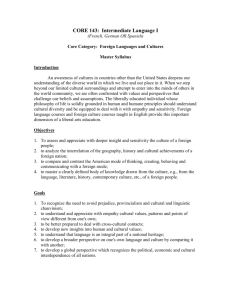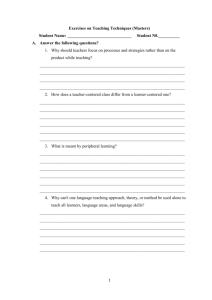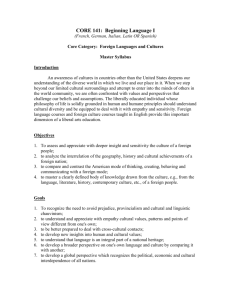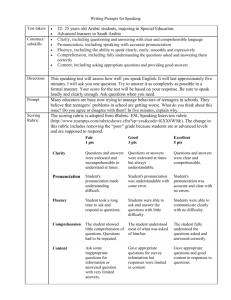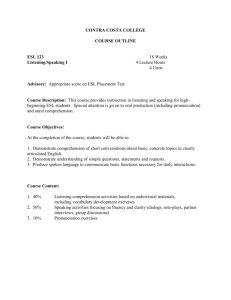BILC TABLE OF LANGUAGE PROFICIENCY LEVELS
advertisement
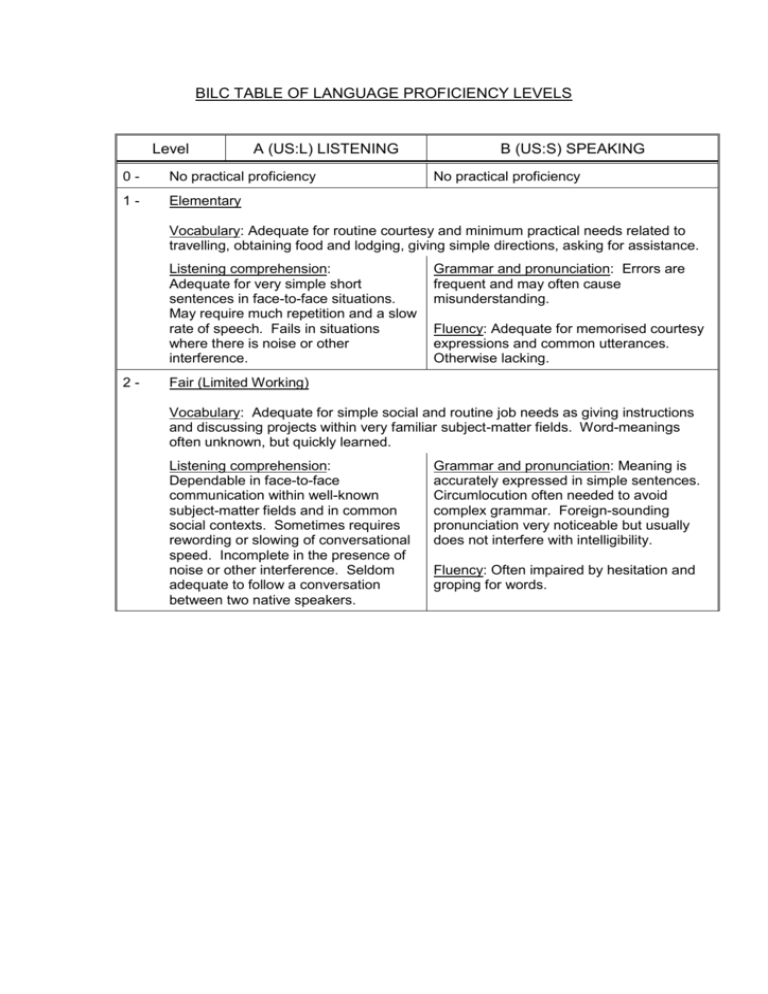
BILC TABLE OF LANGUAGE PROFICIENCY LEVELS Level A (US:L) LISTENING 0- No practical proficiency 1- Elementary B (US:S) SPEAKING No practical proficiency Vocabulary: Adequate for routine courtesy and minimum practical needs related to travelling, obtaining food and lodging, giving simple directions, asking for assistance. Listening comprehension: Adequate for very simple short sentences in face-to-face situations. May require much repetition and a slow rate of speech. Fails in situations where there is noise or other interference. 2- Grammar and pronunciation: Errors are frequent and may often cause misunderstanding. Fluency: Adequate for memorised courtesy expressions and common utterances. Otherwise lacking. Fair (Limited Working) Vocabulary: Adequate for simple social and routine job needs as giving instructions and discussing projects within very familiar subject-matter fields. Word-meanings often unknown, but quickly learned. Listening comprehension: Dependable in face-to-face communication within well-known subject-matter fields and in common social contexts. Sometimes requires rewording or slowing of conversational speed. Incomplete in the presence of noise or other interference. Seldom adequate to follow a conversation between two native speakers. Grammar and pronunciation: Meaning is accurately expressed in simple sentences. Circumlocution often needed to avoid complex grammar. Foreign-sounding pronunciation very noticeable but usually does not interfere with intelligibility. Fluency: Often impaired by hesitation and groping for words. Level 3- A (US:L) LISTENING B (US:S) SPEAKING Good (Minimum Professional) Vocabulary: Adequate for all practical and social conversations and for professional discussions in a known field. Listening comprehension: Adequate to follow radio broadcasts, speech conversations between two educated native speakers in the standard language. Details and regional or dialectic forms may be missed, but general meaning is correctly interpreted. 4- Grammar and pronunciation: Full range of basic structures well understood, and complex structures used. Mistakes sometimes occur, but meaning accurately conveyed. Pronunciation recognisably foreign but never interferes with intelligibility. Fluency: Rarely impaired by hesitations. Flow of speech is maintained by circumlocution when necessary. There is no groping for words. Very Good (Full Professional) Vocabulary: Broad, precise, and appropriate to the subject and the occasion. Listening comprehension: Adequate for all educated standard speech in any situation. Undisturbed by noise or interference in moderate amount. May occasionally have difficulty with colloquial or regional dialect variations. Grammar and pronunciation: Errors seldom occur, and do not interfere with accurate expression of meaning. Non-native speaker pronunciation does not interfere with intelligibility. Fluency: Similar to native fluency in known subject fields. Easy for a native speaker to listen to. NOTE: This level reflects extensive experience using the language in an environment where it is the primary means of communication. 5- Excellent (Native/bilingual) In all criteria of language proficiency, completely equal to a native speaker of the language. This level of proficiency is not achieved by training, and cannot normally be attained except by natives who have been educated through the secondary level in indigenous schools. WRITTEN PROFICIENCY SKILL Level C (US:R) READING COMPREHENSION 0- No practical proficiency 1- Elementary Adequate for street signs, public directions, names on buildings, and elementary lesson material. In languages written by alphabet or syllabify, adequate to spell out unknown words and approximate their pronunciation in order to ask a native speaker the meaning. 2- No practical proficiency Has sufficient control of the writing systems to meet limited practical needs. Can produce all symbols in an alphabetic or syllabic writing system. Can write numbers and dates, his own name and nationality, addresses, etc. Otherwise ability to write is limited to simple lists of common items or a few short sentences. Spelling may be erratic. Fair (Limited working) Adequate for intermediate lesson material and simple colloquial texts such as children's books. Requires extensive use of dictionary to read short news items. Written material seldom fully understood without translation. 3- D (US:W ) WRITING Can draft routine social correspondence and meet limited professional needs. Is familiar with the mechanics of the writing system, except in character systems where ability is limited to a small stock of high-frequency items. Makes frequent errors in spelling, style and writing conventions. Able to write simple notes and draft routine social and limited office messages. Material normally requires editing by a more highly proficient writer. Good (Minimum professional) Adequate for standard text materials and most technical material in a known professional field; with moderate use of dictionary, adequate for most news items about social, political, economic, and military matters. Information is obtained from written material without translation. Can draft official correspondence and reports in a special field. Control of structure, spelling, and vocabulary is adequate to convey his message accurately, but style may be quite foreign. All formal writing needs to be edited by an educated native. Level 4- C (US:R) READING COMPREHENSION D (US:W ) WRITING Very Good (Full professional) Adequate to read easily and with minimal use of dictionaries, styles of the language occurring in books, magazines and newspapers written for an audience educated to the level of a high school graduate. Adequate to read technical and abstract material in known professional fields. Can draft all levels of prose pertinent to professional needs. Control of structure, vocabulary, and spelling is broad and precise; sense of style is nearly native. Errors are rare and do not interfere with understanding. Nevertheless, drafts or official correspondence and documents need to be edited by an educated native. NOTE: This level reflects extensive experience using the language in an environment where it is the primary means of communication. 5- Excellent (Native/bilingual) In all criteria of language proficiency, completely equal to a native speaker of the language. This level of proficiency is not achieved by training, and cannot normally be attained except by natives who have been educated through the secondary level in indigenous schools.
